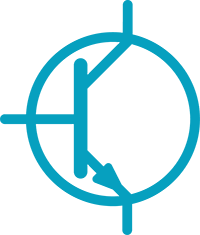About
PECTA has been approved by the 4E ExCo (decision: November 2018) to start in March 2019 with an introduction phase (2019-2020), followed by an establishing phase (2020-2024). The introduction phase is split into two different major tasks and the supporting work of the industrial advisory group.
Introduction Phase 2019-2020
Task 1: Efficiency Potential in Power Electronic Applications
With the rise of WBG semiconductors such as silicon carbide (SiC) and gallium nitride (GaN), it is expected that existing efficiency limits will be pushed further, for existing systems (for example, even smaller chargers) and entirely new applications. Therefore, this task will identify potential power electronic applications which could experience savings by employing the new WBG-semiconductors. Based on the analysis of specific applications, the extent of potential savings of these applications shall be estimated, over the short term and long-term. Moreover, this task will also examine recommendations to policy-makers on possible measures in order to support the market entrance of WBG devices.
Task 2: Roadmaps for Power Devices
Both silicon and wide bandgap semiconductor devices experience a constant push towards higher power performance, along with demand for ruggedness and reliability. This development leads to a steady release of new generations of key components (diodes, switches) exhibiting higher voltage or current ratings and, potentially, operating at higher frequencies. SiC and GaN-based technologies are recently the subject of roadmap initiatives which vary slightly by region. Part of this task is to identify and discuss these efforts in order to determine a global view for policymakers.
Established Phase 2020-2024
Task A: Completion and updating available efficiency figures
This task will assess the energy efficiency potential from using WBG semiconductors in different applications, with a focus on those applications with higher potential. This will mainly include mobile phones, laptops, desktops, data centers, residential battery storage and PV energy generators, drive inverters for small and medium motors and for servo-drives, electric vehicle chargers and HVACR-Appliances with variable speed drives. This task is led by the Austrian Institute of Technology (AIT) and is planned from 2020 until 2024.
Task B: Energy and environmental related Life Cycle Assessment (LCA)
This task is focused on investigating the environmental aspects and impacts of WBG technology over its life cycle, and compared to existing Silicon based technologies for selected applications. An in-depth analysis of impacts and benefits looks into the specific environmental and energy aspects and impacts of SiC and GaN, under plausible production, adoption, and use scenarios. This task is led by Austria, with experts from the Vienna University of Technology, and is planned from 2020 until 2023.
Task C: Revision of elaborated Application Readiness Map (ARM)
Based on the work of phase 1, this is a follow up to update the recent Application Readiness Map (ARM) developed and published by PECTA. The ARM visualizes the development of WBG technologies for several applications and voltage levels until 2035. This task is led by the Austrian Institute of Technology (AIT), and revised ARMs shall be available in 2022 and in 2024.
Task D: Policy measures and mapping with applications over a timeline
Task D tackles the policy landscape of WBG technology. The scope of this task is identifying and assessing possible policy measures in relation to the development of WBG technology presented in the Application Readiness Map. To realize the energy efficiency potential from WBG technology, policy makers need to consider the timing and the suitable policy measures that could ease the market entrance and the adoption of WBG for particular applications and devices. The feasibility of horizontal and/or vertical regulatory approaches will be assessed, as well as the benefits of possible policy and other support measures. This task is jointly led by Denmark and Sweden, is planned from 2020 to 2022, and will engage experts from Aalborg University, Denmark (Section Power Electronic Systems).
Task E: Standards to support WBG adoption
This task aims at developing global accepted efficiency standards for WBG semiconductors, to promote their adoption in end-user equipment and appliances. Standardised energy efficiency measurements and declarations are currently lacking, making it difficult for users to accurately compare the efficiency of devices based on different technologies. With these initial steps the basic guidelines for a proper and elaborated method of efficiency measurements as base for standardization will be established. This task is led by the Swiss Federal Office of Energy, will engage experts from industry and the IAG, and is planned from 2020 to 2024.
Task F: Measurement of power supply efficiency
This task shall concretely measure the energy efficiency of WBG-based and Si-based power supplies for mobile and non-mobile ICT-appliances, to compare and better understand their performance, as well as associated features and advantages. This highly technical and truly collaborative task is led by the Swiss Federal Office of Energy, and engages laboratories from Switzerland (Power and Wideband Gap Electronic Research Lab of the Ecole Polytechnique Fédérale de Lausanne, EPFL), and Austria (AIT Austrian Institute of Technology) as well as skilled experts and researchers from Sweden and Denmark. It will last from 2020 until 2024; with interim results published as soon as they become available.
Task G: Optimized SiC PV Inverter
This task looks into commercially available PV inverters. It will be addressed which semiconductors (Si, SiC, hybrid), topologies and switching frequency are utilized and tries to identify further potential in terms of electrical energy efficiency, based on existing modules available on the market. This Task is a collaboration between Austria and Switzerland.
Supporting work of industrial advisory group
The members of the industrial advisory group are mainly drawn from industry, which are working in the area of materials, semiconductor devices, modules or belong to corresponding system manufacturers. The Group will act as industrial liaison to ensure that new research and development results, market information, economical aspects etc. are identified and considered by PECTA. The industrial advisory group gives regular input to the running tasks, interacts with them and critically reviews the output of the tasks. The results of the reviewing process will be fed back to the task via task leaders and will be incorporated correspondingly by them.


































